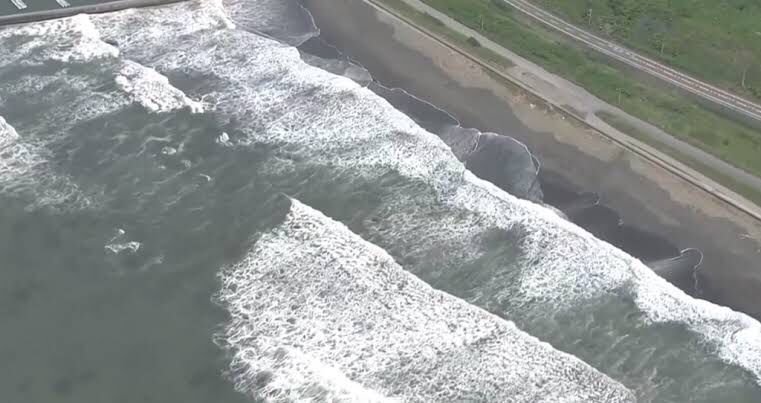
Tsunami warning issued for Hawaii after 8.8-magnitude earthquake hits Russia's far east. Image: Sky News.
(The Post News)– Hawaii remains under a tsunami warning after a powerful 8.8-magnitude earthquake struck Russia’s Far East, triggering tsunami waves in Japan and Alaska and prompting warnings for North and Central America and Pacific islands. The Pacific Tsunami Warning Center (PTWC) said the estimated arrival time of the first tsunami wave in Hawaii was 7:17 p.m. local time.
The tsunami waves were relatively small, but they arrived at a time of high tide, according to CBS Honolulu affiliate KGMB-TV. The Oahu Department of Emergency Services said tsunami waves were currently impacting Hawaii, urging people to take action immediately.
The PTWC reported that the Hilo, Hawaii gauge recorded a tsunami height of 4.9 feet relative to normal sea levels, and the Kahului Maui gauge recorded a tsunami height of four feet. People were urged to move inland, and shelters were opened in many parts of Hawaii.
Pacific Tsunami Warning Center director Chip McCreery said it would take several hours to determine if the warning could be lowered to an advisory level, and it might not be until the next morning before the warning could be completely canceled. The impact of the tsunami could last for hours or even more than a day.
The tsunami is expected to cause a series of powerful waves over a long period, said Dave Snider, tsunami warning coordinator with the National Tsunami Warning Center in Alaska. Tsunamis can travel at hundreds of miles per hour in deep water but slow down and pile up near the shore, causing inundation problems.
Hawaii Governor Josh Green said data from Midway Atoll measured waves from peak to trough of 6 feet. He warned that waves hitting Hawaii could be bigger or smaller, and it was too early to tell how large they would be. A tsunami of that size would be akin to a 3-foot wave riding on top of surf.
The Oregon Department of Emergency Management said small tsunami waves were expected along the coast starting around 11:40 p.m. local time, with wave heights between one and two feet. It urged people to stay away from beaches, harbors, and marinas and to remain in a safe location away from the coast until the advisory is lifted.
The central government said the quake had a preliminary magnitude of 8.0, later updated to 8.8 magnitude by the U.S. Geological Survey. The quake was centered about 74 miles east-southeast from the Russian city of Petropavlovsk-Kamchatsky, which has a population of 180,000, on the Kamchatka Peninsula.
Multiple aftershocks as strong as 6.9 magnitude followed the earthquake. The first tsunami wave hit the coastal area of Severo-Kurilsk, the main settlement on Russia’s Kuril Islands in the Pacific. Residents were safe and staying on high ground until the threat of repeat waves was gone.
About 2,700 people were evacuated to safe locations on the Kuril Islands. Buildings were damaged, and cars swayed in the streets in Petropavlovsk-Kamchatsky. Russian news agencies reported that several people sought medical help in Kamchatka after the temblor, but no serious injuries were reported.
The earthquake appeared to be the strongest anywhere in the world since the 9.0 magnitude earthquake off northeastern Japan in March 2011 that caused a massive tsunami that set off meltdowns at a nuclear power plant. Only a few stronger earthquakes have ever been measured around the world.
The tsunami alert disrupted transportation in Japan, with ferries, trains, and airports in the affected area suspending or delaying some operations. A tsunami of 2 feet was recorded at Hamanaka town in Hokkaido and Kuji port in Iwate. Several areas reported smaller waves, including 8 inches in Tokyo Bay five hours after the quake.
In Japan’s northern coastal town of Matsushima, dozens of residents took refuge at an evacuation center, where water bottles were distributed and an air conditioner was running. One person told NHK she came to the facility without hesitation based on the lesson from the 2011 tsunami.
The quake was the strongest to hit this area on the Kamchatka Peninsula since 1952, according to the local branch of the Geophysical Survey of the Russian Academy of Sciences. They said that while the situation “was under control,” there was a risk of aftershocks, which could last for up to a month, and warned against visiting certain coastal areas.
There are four levels of tsunami alerts: warning, advisory, watch, and information statement, according to the National Weather Service. A tsunami warning is the most severe alert, meaning residents should take action due to a tsunami that may cause widespread flooding.



